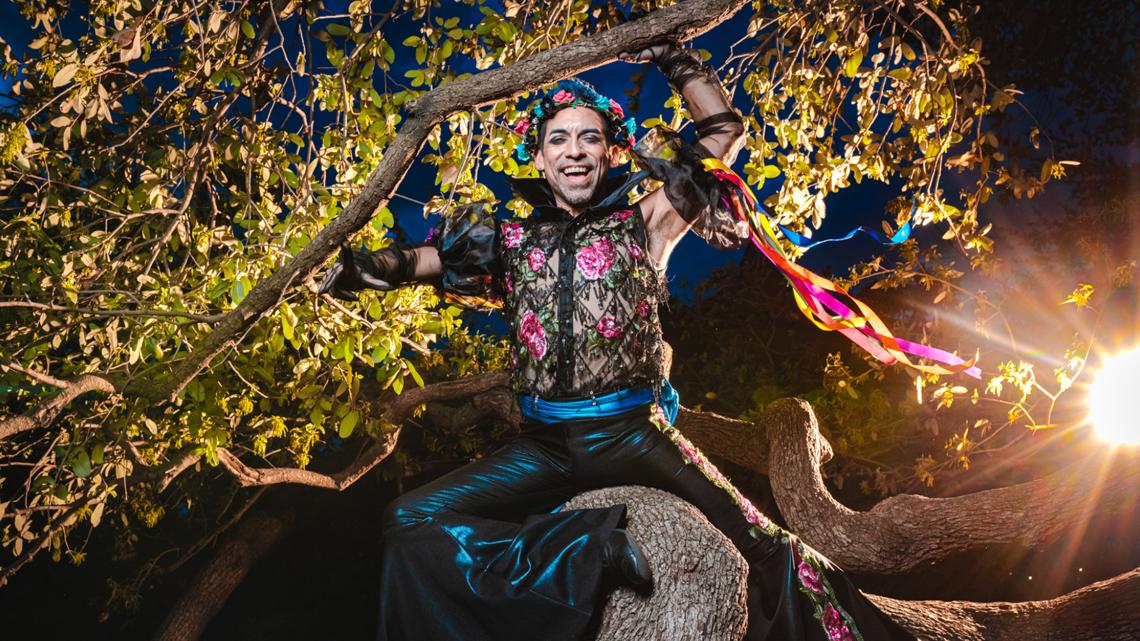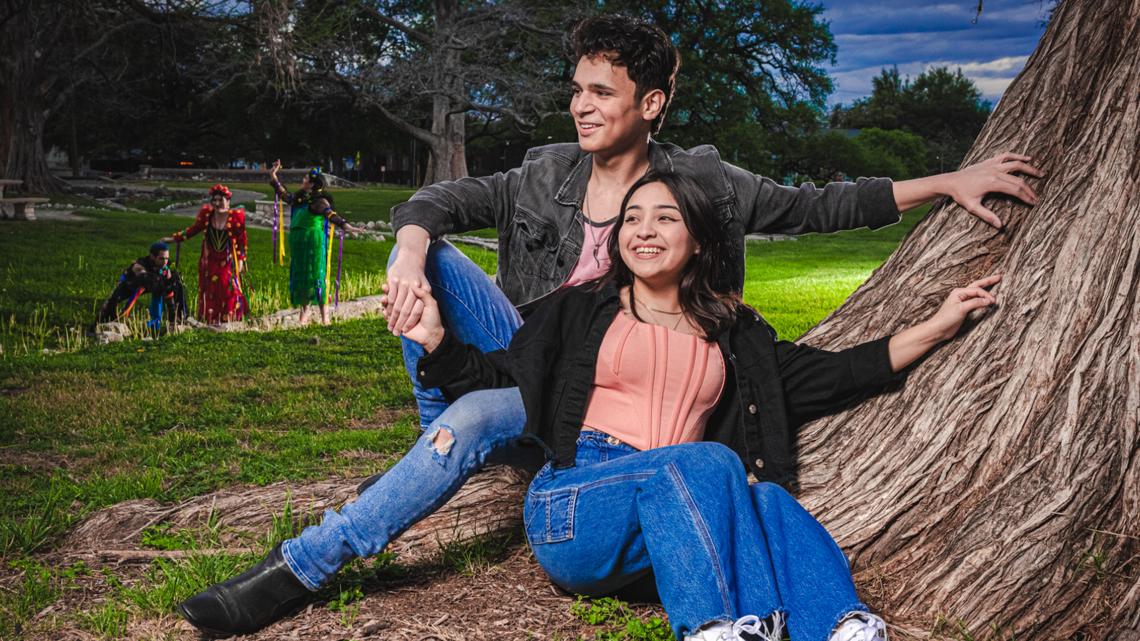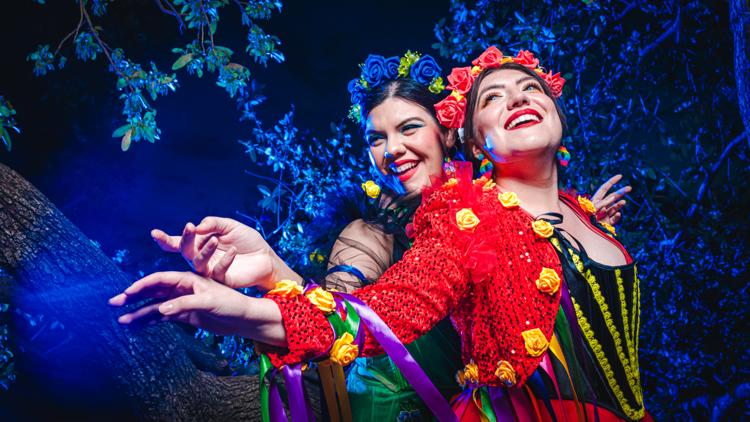SAN ANTONIO — Athenian courtyards become historic San Antonio districts, classical music is energized by mariachis and woodland fairies are dancing folklórico in “Midsummer Sueño,” premiering this week at San Pedro Springs Park.
The colorful magic of South Texas culture makes it uniquely suited to serve as the backdrop for this adaptation of William Shakespeare’s “A Midsummer Night’s Dream,” a joint production by the Public and Classic theater organizations. The Bard’s play is a magical tale in its own right. That might be why, according to the show’s artisans, it was easy to take various ideas and pursue them to their natural Alamo City conclusions.
“That’s the challenge with original theatre: Everyone needs the materials yesterday, before rehearsals start,” said Jaime Ramirez, the Public’s music director. “But we’re inventing this; it evolves and it’s organic. It’s cool to have people who are cool with that and rolling with it.”
“A Midsummer Night’s Dream” follows multiple storylines and a medley of memorable characters who make the play at once a romance, a comedy, a drama and a fantasy. Like many of the most famous Shakespearian works, the roughly 430-year-old story has gone through a carousel of permutations, from Japanese anime to 1890s Italy to contemporary Los Angeles. Woody Allen, true to form, even directed “A Midsummer Night’s Sex Comedy” in the ‘80s.
“Midsummer Sueño” will be decidedly more family-friendly than Allen’s take, and also decidedly more Tejano. It’s a grand undertaking, both in an aesthetic sense and a personal one; the show represents a return to the theater world after 25 years for Paco Farias, the 52-year-old writer and director of “Midsummer Sueño”. For years he's been working in the world of TV and film (“The Long Game,” a movie he co-wrote about the championship-winning Del Rio Mustangs golf team, also hits theaters this weekend).
The way Farias discussed it in a recent interview with KENS 5, months after first signing on and with opening night not far off, the reunion may have been overdue.
“It’s hard not to get emotional at times,” he said. “Every now and then you do something with a group of people that just feels right. For lack of a better word, it’s magical.”
Adapting a classic
But magic of the performing arts variety doesn’t just appear out of thin air. Before the actors were cast and sets were designed, a script first needed to be written.
“I lost a little bit of sleep over it, especially since they wanted me to adapt Shakespeare,” said Farias, who was approached by Public Theatre President Asia Ciaravino last fall to adapt Shakespeare’s story for a San Antonio audience, and ultimately direct it as well. It was to be his first stab at playwrighting.
“But once I dove in, the process was a lot of fun.”
Writing the script took Farias about two months, a process that might’ve taken longer had the gears of Hollywood not stopped in its tracks because of 2023’s strikes – “My work had dried up,” Farias says – ultimately freeing him up to send pages to Classic Theatre Artistic Director Jimmy Moore faster than Moore could read them.
One early goal was to avoid cliché. In San Antonio parlance, that meant not feeling beholden to using the Alamo or River Walk as a setting.
That’s how he arrived at the idea of setting “Midsummer Sueño” in Hot Wells and staked his objective to make the show both familiar in its ambience but also “exotic enough that it would feel magical.”
“I wanted to get down to the feeling we associate (with the city). We did want water, we did want lights, we did want the stone that we see with the missions.”


“Midsummer Sueño” is both a contemporary take on “A Midsummer Night’s Dream” and a compacted version of it, running at about two hours including an intermission. That meant dropping outdated subplots and jokes while infusing Shakespeare’s words with Spanish and clarifying changes (he estimates about 85% of the story’s original verse is retained in his script).
“I got to work pinche guey into iambic pentameter,” Farias said with a chuckle. “I think that’s one of the things I’m most proud of.”
‘Holding on for dear life’
Not long after Farias got to work, Ramirez joined in to help shape a key element not only of the story but of its San Antonio setting: the music.
To that end, “Midsummer Sueño” enlists local musicians – including members of the cumbia group Volcán and a harpist who is “possibly the best in the country” – and dancers to fill out its ensemble. And while the Public’s prior production “American Mariachi” prepared Ramirez for the challenge of intertwining theater and live music in the style they were adopting, he says embarking on work for a production this tonally original was a challenge as daunting as it was exciting.
“What got me rolling is just one tiny seed, a prompt,” Ramirez said.
For him, the seed was Farias’ idea to incorporate the Son Jarocho style of Mexican folk music, including the song “El Cascabel.”
“Then the lights start blinking,” Ramirez said. “The whole show starts writing itself musically, and it’s off to the races.”
According to the collaborators, that “off to the races” spirit cascaded throughout the whole cast and crew, from the costume designers to the actors. Ramirez has plenty of experience writing music for local theatre productions, but the Son Jarocho style was a new way of “furthering the local vibe of it all.”
It’s in the show’s details and in the adjustments made to the Bard’s characters. Even their very names have been adjusted to compensate for the changing in setting: Hermia is now Ermida, Lysander is Lisandro, Helena is Elena.
Elsewhere in “Midsummer Sueño,” folklórico dancers serve dual roles as denizens of the fairy world and also as percussionists of the troupe practicing for a play to be rehearsed at the climactic wedding. And when one character refers to another as “viper” in a tense moment, the fairies shake sonajas to mimic the sound of a rattlesnake.
“It’s southwest, it’s folklórico, but it just made sense,” Farias says. “It’s stuff like that, and all the people involved can bring that once we’ve agreed on theme. It’s easy for them to jump off and come up with newer, better ideas that elevate everything. As director, I’m just buckling in and holding on for dear life.”
Its own identity
The spirit of collaboration fueling “Midsummer Sueño” means ample local talent is featured among its artisans. That includes local acting talent like 20-year-old Andrew Treviño, who plays Lisandro.
Though Treviño had an awareness of the source material going into his first show with the Public, he says the end result isn’t entirely what he thought it might have looked like at the start.
“I wasn’t expecting it to be able to blend so well with modern English and have the Spanish language incorporated so easily,” he said of Farias’ script. “It’s almost like if you read it for the first time, it’s not even Shakespeare. It takes on an identity of its own.”
“Midsummer Sueño” also marks the Public Theatre debut of the actress playing Ermida, 19-year-old Lucy Perez. A drama student at San Antonio College, Perez says the cast’s all-in-this-together attitude helped set them up for success while the production took on a unique life of its own.
“The process has been great,” she said. “Anytime I’m like, ‘Guys, what does this word mean!’ they helped me. We just help each other learn the language and rhythm.”


While Treviño and Perez are working with experienced actors, the iambic pentameter famously and often deployed by Shakespeare may present a challenger to younger ones like themselves; the style incorporates a rhyming structure somewhere between regular spoken dialogue and song, and doesn’t leave room for improvisation if one forgets their lines.
The whole “Midsummer Sueño” cast is also expected to put on their dancing shoes late in the show for a centerpiece musical sequence that Farias says takes after the spontaneous joy of a quinceañera and is propelled by Ramirez’s original compositions.
“It has to feel like a family has put this dance together to celebrate,” Farias said. “It’s off the cuff, like they practiced it in their backyards.”
Though audiences will see something that’s been thoroughly refined and rehearsed when they watch “Midsummer Sueño,” it comes from a place that is exactly that: off-the-cuff with its ideas, manifested with commitment to do both Shakespeare and the Alamo City justice.
At the same time, the show is about upending expectations at a time when San Antonio theater organizations are increasingly thinking outside the box with the stories they’re telling, how they’re telling them and who they’re enlisting to help tell them. Farias says he hopes “Midsummer Sueño” does that for audiences who only think they know the tale of Helena and Hermia, of Demetrius and Lysander, or Titania and Oberon.
“I want them to go, ‘Woah, OK, that’s awesome. I never thought about it like that,’” the first-time playwright said. “That’s the first challenge, the ones that say, ‘Let’s see that Shakespeare. Let’s see what you’ve got.’”
For the show’s youngest stars, modernizing the words of of history’s most famous playwright has already reaped rewards of a more personal scale. Treviño says the produced was an opportunity for him to reconnect with his heritage, and the value of representation isn’t lost on Perez.
“I feel it’ll really speak to people,” she said. “I think this is going to represent what San Antonio is, what it’s built on."
“Midsummer Sueño” runs through Sunday at San Pedro Springs Park. Tickets start at $25 for adult general admission, while those 18 and under get in for free. Buy here.
>TRENDING ON KENS 5 YOUTUBE:



